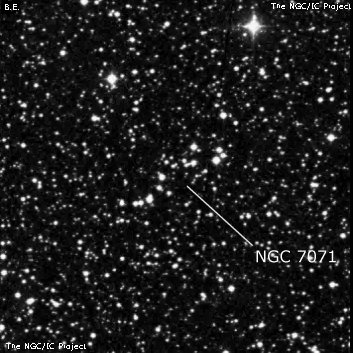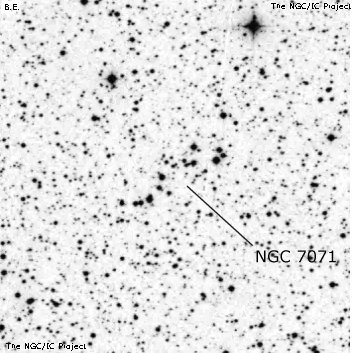NGC/IC Project Restoration Effort
(This is a very very beta version)
NGC7071


Basic Information
Location and Magnitude
Right Ascension: 21:26:40.0
Declination: +47:55:22
Constellation: CYG
Visual Magnitude:
Historic Information
Discoverer: Herschel J.
Year of discovery: 1829
Discovery aperture: 18.3
Observational
Summary description: Cl, S, C, cE
Sub-type: *Grp
Corwin's Notes
=====
NGC 7071. JH says of this, "A very poor and small cluster of an oblong
figure. It is followed by a loosely scattered mass of stars." JH's cluster
itself is obvious -- an elongated group of about a dozen stars, just 3.3 by
1.0 arcminutes in size, at his position. His "loosely scattered mass of
stars", however, could refer to any of the clouds of stars in this pretty rich
Milky Way field.
Reinmuth suggested that this might be another observation of NGC 7067 (which
see), an idea picked up by RNGC. However, JH's descriptions preclude this --
they are too different to refer to the same object. In any event, both
positions have "clusters" that match JH's admittedly scanty descriptions.
Finally, I think this is simply an asterism. As with all these, we need to
get into the astrophysics to determine its true nature.
Also see NGC 7011 where this has some bearing on the identification of that
object.
Steve's Notes
=====
NGC 7071
18" (10/8/05): this "nonexistent cluster" is located in a glorious low power Milky Way field. Several groupings (both large and small) caught my eye at 73x (67' field), but I was mostly drawn to a fairly distinctive 4' string of stars oriented NW-SE. At 225x, ~15 stars were packed into the string, most stars being mag 13-14 with a few fainter stars, and possibly over unresolved Milky Way background glow. This group would have likely caught John Herschel's eye as he swept the region, though it may be an asterism (not in Lynga).



